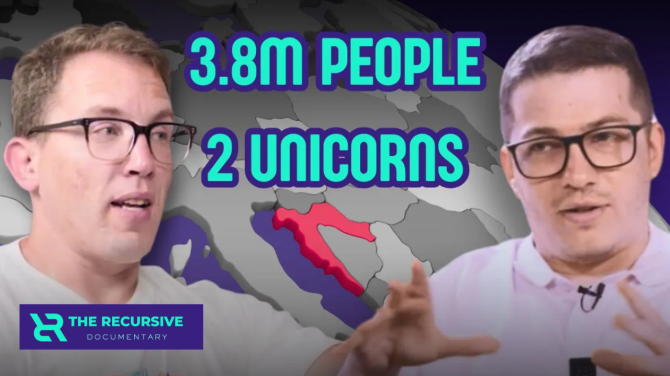For many startups, public relations feels like one of those things you can hack. Write a press release, blast it to dozens of journalists, and coverage will follow — or so the thinking goes. Over the past few years, the rise of automation and AI tools only reinforced that belief: why hire an agency when software can generate pitches and contact lists in minutes?
But founders quickly learn that PR isn’t just about speed of distribution and hype. A great pitch lives or dies on its angle, its timing, and the trust behind it. Journalists don’t respond to announcements because they’re polished; they respond because the story feels relevant, credible, and timely.
To explore why DIY PR so often underdelivers, I sat down with The Recursive CEO Teodor Antonio Georgiev, also founder of Storytelling Studio, a tech PR agency through which he helped countless regional startups, and Stamatis Astra, Chief Business Officer at Intelligent Relations, a company that is building and marketing its own AI-driven PR platform.
We spoke about what are the staples of good public relations, why in some cases the DIY model is (not) delivering – and last but not least, how to get journalists attention.
What is newsworthy about your startup?
Founders often underestimate just how much the angle makes or breaks coverage. “We’ve seen it all — especially founders so deep in their product that they become blind to what’s actually compelling,” says Teodor. “The best move? Ask your investors why they backed you. It’s often the clearest signal of your edge.”
Instead of glorified self-promotion, credibility comes from weaving the founder’s story into something bigger. On top of that, both Teodor and Astra agree: the foundation of good PR is clarity and newsworthiness.
“You need a strong headline, a tight lead, a clear why now, and social proof — traction, funding, or partnerships,” says Teodor. But even more importantly: the press release should read like a story, not a corporate brag sheet.
“We’ve had founders insist on centering themselves in the announcement — writing what amounts to a glorified LinkedIn CV instead of a news piece,” recalls Teodor. “That’s a branding campaign, not a PR campaign. And it frequently hijacks the story from the actual innovation.”
Astra echoes the point: “If it’s not actually news, then it’s not a press release. It’s a blog post or a LinkedIn update. A good release needs to be concise, factual, and informative, but it should also tell a story about why this announcement matters in the bigger picture.”
“Journalists aren’t looking to pat your team on the back – they’re looking for information that helps their audience understand a trend, a challenge, or a change in the market,” adds Astra. “Put your ego aside and focus on why the average reader should care. If you can connect your announcement to a broader issue, you’ll give reporters a reason to see it as more than just a company milestone.”
Launching a product? Don’t just describe its features. Explain how it changes the game, reflects a shift in the market, or solves a problem no one else has cracked. Also, don’t underestimate the importance of your product journey, talk openly about your process and how you developed something from scratch, even better if it’s with users feedback…
Even if startups manage to DIY killer press releases — that is only half of the battle.
“Distribution and positioning,” says Teodor. “A press release is a tool, not a strategy. Most startups write and pray. Communication experts engineer timing, angles, and influence.”
A release, in other words, is a starting point — not the whole of PR. Astra stresses that credibility doesn’t come from one-off announcements, but from consistently showing up with something meaningful to say. That might mean contributing informed takes to industry publications, sharing original research, or being the expert a journalist calls when news breaks.
Visibility also comes from plugging into the bigger conversations. “Tie your perspective to market shifts, emerging technologies, and changes in consumer behavior,” Astra explains, “so journalists and their audiences can immediately see how your story fits into issues they care about.”
This is why one press release rarely translates into actual coverage.
“Media doesn’t care about your timeline — they care about relevance,” Teodor notes. “Most startups overestimate how newsworthy they are. One release, especially if not tied to a broader story or trend, usually dies in inbox purgatory.”
Real coverage comes from persistence, relationships, and relevance. Without that, a press release is just another cold call, easily ignored.
The invisible work that makes the biggest difference
Still, PR overall seems deceptively simple to many of the founders: you send out a pitch, and then an article appears. What they rarely see is the work that happens long before any announcement goes public…
“Narrative architecture, media mapping, and momentum design,” says Teodor. “Before anything goes live, we study competitor coverage, test angles in soft launches, and time announcements to news cycles or investor movement. Founders, they see the article. What they don’t see is the 10 hours of preparation behind each pitch.”
Much of PR’s value lies in work that doesn’t produce instant results but pays off later. Astra points to the painstaking cultivation of relationships between PR pros and journalists. A founder might think a story appeared because they hit “send” yesterday — but the reality is that their PR team has often been building trust for months, sharing insights, flagging trends, and waiting for the right moment to introduce a story.
“Good PR is a long game,” Astra explains. “Your PR team is constantly laying groundwork with the right reporters and editors so that when you do have something to say, those journalists are already paying attention.”
If you still want to do it yourself – watch out for…
For all the talk about AI tools and DIY hacks, many founders who try to run their own PR learn the hard way that it’s not as simple as writing a pitch and hitting send.
“They confuse marketing speak with media language,” says Teodor. “Founders often talk to journalists like they’re pitching customers — but they’re not in a sales process. What they lack is editorial empathy. You need to understand how the media thinks, what qualifies as news, and how to provide value beyond your product.”
One common misstep is assuming that milestones, like closing a funding round, are automatically newsworthy. “It happens every day,” he adds. “If you don’t contextualize it — why now, why this market, what’s the bigger shift — it’s just noise.”
Astra agrees that the DIY route often fails because founders approach media as if it were a volume game. They fire off mass emails full of jargon and self-praise, convinced that if they tell enough people they’re “revolutionary,” someone will bite.
“The reality is, journalists get dozens of pitches a day, sometimes hundreds,” Astra explains. “Most are irrelevant, overly promotional, or lazily personalized. An agency, or any experienced PR pro, knows that publications don’t owe you coverage. You have to earn it by showing why your story matters right now — to that reporter’s audience, and in the broader news cycle.”
Following that, Astra concludes with three most common DIY PR mistakes:
-
- Thinking PR is a magic bullet for growth. Some founders treat PR like a replacement for marketing, sales, or even product strategy. “We’ll get one big hit in the Wall Street Journal and customers will flood in.” It doesn’t work like that.
- Over-pitching irrelevant stories. Weekly press releases for minor updates, cold-emailing any journalist whose email they find, regardless of fit. These are surefire ways to end up in the junk folder – and eventually on the block list.
- Putting unprepared spokespeople in the spotlight. Think founders who can’t turn off “sales mode,” who get defensive under tough questions, or who treat interviews like product demos. That’s a fast way to wear out your welcome with the media.







